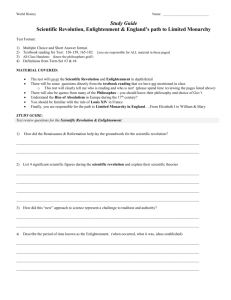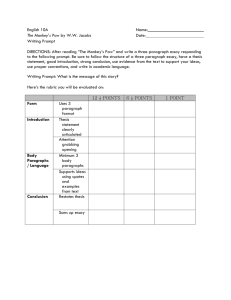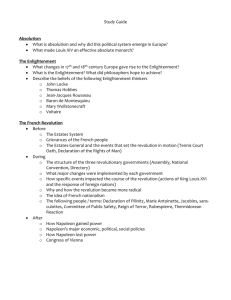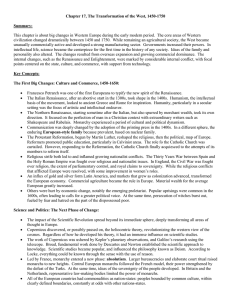AP Long Essay Reteach
advertisement
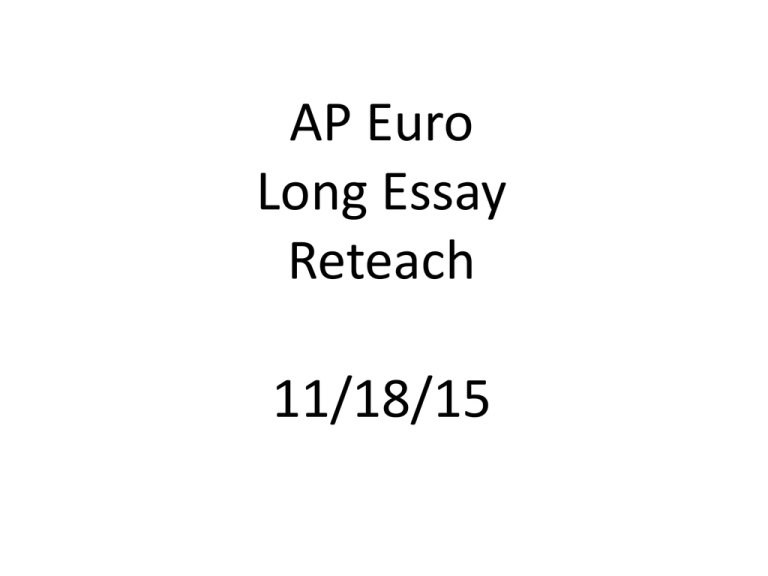
AP Euro Long Essay Reteach 11/18/15 Part 1: The Prompt How do I analyze a prompt? 1)READ IT! No, seriously – read the entire thing. 2)Underline, circle, highlight, etc., the important parts of the prompt you MUST answer. 3)Number each part of the prompt you have to answer. 4)Then list them. 5)You now have a checklist when you’re outlining the rest of the essay and writing your thesis and paragraphs. Here is an example: Prompt: Evaluate the extent to which European social and political developments during the Enlightenment were a result of the Scientific Revolution. Evaluate the extent to which European social and political developments during the Enlightenment were a result of the Scientific Revolution. Evaluate the extent to which European social and political developments during the Enlightenment were a result of the Scientific Revolution. 1) 2) 3) 4) 5) 6) Evaluate EXTENT Social and political developments Enlightenment Were a RESULT of… The Scientific Revolution So now that you have all of that, what exactly are you supposed to argue? Take your list again: 1) 2) 3) 4) 5) 6) Evaluate EXTENT Social and political developments Enlightenment Were a RESULT of… The Scientific Revolution And reword it into something easier to answer: Explain how much impact the Scientific Revolution had on social and political developments during the Enlightenment. 1) 2) 3) 4) 5) 6) Evaluate EXTENT Social and political developments Enlightenment Were a RESULT of… The Scientific Revolution Same prompt: Evaluate the extent to which European social and political developments during the Enlightenment were a result of the Scientific Revolution. Different wording: Explain how much impact the Scientific Revolution had on social and political developments during the Enlightenment. Now it’s your turn – write down the prompt, highlight, underline, whatever, then list the important parts of the prompt. Then reword into something more manageable but will still cover everything in the original prompt. Practice prompt: Evaluate the extent to which the role of the monarchy contributed to maintaining continuity as well as fostering change in European society from 1603 to 1740. Evaluate the extent to which the role of the monarchy contributed to maintaining continuity as well as fostering change in European society from 1603 to 1740. Evaluate the extent to which the role of the monarchy contributed to maintaining continuity as well as fostering change in European society from 1603 to 1740. 1) 2) 3) 4) 5) 6) 7) 8) Evaluate EXTENT ROLE of the monarchy Contributed Maintaining continuity Fostering change European society 1603-1740 Explain how much the actions/functions of kings and queens during 1603-1740 contributed to European society staying the same BUT ALSO changing. 1) 2) 3) 4) 5) 6) 7) 8) Evaluate EXTENT ROLE of the monarchy Contributed Maintaining continuity Fostering change European society 1603-1740 Same prompt: Evaluate the extent to which the role of the monarchy contributed to maintaining continuity as well as fostering change in European society from 1603 to 1740. Different wording: Explain how much the actions/functions of kings and queens during 1603-1740 contributed to European society staying the same BUT ALSO changing. Some things to remember with the prompt: 1) All prompts are different! You must read each one and not assume you know what it’s asking. 2) Annotating the prompt and rewording it should only take 1-2 minutes. Don’t spend longer than that. 3) Practice with old prompts so you can get faster at it. 4) Misreading ONE word can change the entire meaning of the prompt. READ CAREFULLY! Part 2: Brainstorming Why brainstorm? 1)Brainstorming will help you organize the ideas for your essay. 2)Jotting down ideas will hopefully trigger your memory for more information. 3)Many students don’t do this step and suffer because of it – their essays are not organized and lack specifics. 4)This step is critical if you want to perform well on essays (DBQs too). How do I do it? 1)Once you’re done annotating the prompt, jot down ANYTHING that comes to mind about the prompt. 2)List people, places, things, events, ANYTHING that happened in the time period. 3)Do this for about 1 minute. 4)Now, go back and cross out anything that wouldn’t fit in your essay. For example, you write down an artist but the prompt is about politics – cross out the artist. 5)Spend about 1 minute doing this. Example: Evaluate the extent to which European social and political developments during the Enlightenment were a result of the Scientific Revolution. Literacy Reason & logic Galileo Science academies Newton Locke Baroque Neoclassicism Rococco Enlightened Absolutism Mechanism Deism Science vs. religion Hobbes Old vs. new Copernicus Peter the Great Glorious Revolution Now – get rid of anything that probably won’t fit in your essay: Literacy Reason & logic Galileo Science academies Newton Locke Baroque Neoclassicism Rococco Enlightened Absolutism Mechanism Deism Science vs. religion Hobbes Old vs. new Copernicus Peter the Great Glorious Revolution Your turn again – brainstorm for 1 minute for the prompt you annotated earlier, and then get rid of anything that you don’t need for another minute. Practice prompt: Evaluate the extent to which the role of the monarchy contributed to maintaining continuity as well as fostering change in European society from 1603 to 1740. Example: Elizabeth I James I Peter the Great Louis XIV Charles I William & Mary 30 Years’ War Scientific Rev Glorious Rev Enlightenment English Civil War French Wars of Religion Absolutism Mary I Baroque Example: Elizabeth I James I Peter the Great Louis XIV Charles I William & Mary 30 Years’ War Scientific Rev Glorious Rev Enlightenment English Civil War French Wars of Religion Absolutism Mary I Baroque Some things to remember: 1)You don’t have to use everything you’ve brainstormed. It’s just a starting point – add and cross out as needed. 2)Make sure to check the clock – spending too much time brainstorming will take away from actually writing the essay. 3)You need to KNOW the content to do this well. If you’re clueless about the topic, you could spend an hour brainstorming and still have nothing. STUDY! Part 3: Outlining Your Body Paragraphs So you’ve annotated the prompt and brainstormed . . . what now? Here’s what I’ve noticed: 1) Students tend to get stuck here (earlier too of course) because they’re not sure WHAT to argue in the body paragraphs. 2) Students are unsure of WHERE to put their information once they’ve brainstormed. 3) Students don’t know how to separate their essays into topics or themes, so information gets all jumbled up. 4) Students end up being vague in their essays because they don’t know what point they’re arguing so they ramble. Did any or all of that sound like you? Here’s how to avoid those problems: 1) The prompt is your friend. Look at it to figure out how to separate your body paragraphs. 2) Right now, simpler is better. Learn how to organize your essay and then slowly, start to up the level of sophistication. 3) Think of paragraphs like categories – you’re sorting your information according to a category or theme. Don’t scramble your information together. 4) You must take a stance in your paragraphs but it’s easy to do so – if you are arguing that the Scientific Revolution had a huge impact on the social developments of the Enlightenment, then that IS your stance! Here’s how to use the prompt to help outline: 1) Look back at the prompt and what it’s asking you to do: Evaluate the extent to which European social and political developments during the Enlightenment were a result of the Scientific Revolution. 2) Look for the topics of the prompt. Here it’s SOCIAL and POLITICAL DEVELOPMENTS during the Enlightenment. 3) Now, I know I’ve said you need three body paragraphs in class before, but you can have two. This prompt can easily be two. 4) You take the topics and those are your body paragraphs: a) Social developments b) Political developments 5) Now you have the basic outline. But wait, where’s your argument?? Turning paragraphs topics into arguments: 1) You have your topics, but just stating them doesn’t make them arguments. 2) You have to take a stance. So look at the topics again: a) Social developments b) Political developments And take a stance…. a) Social developments – Scientific Revolution had an impact on these to a big extent b) Political developments – Scientific Revolution had an impact on these to a big extent 3) Great! Now you’ve taken a stance! But wait… aren’t those a little vague?? Now you have to make them SPECIFIC and say HOW the Scientific Revolution had an impact on those topics. How to make your argument specific: 1) Your brainstorm is now your friend. You’ve listed a ton of stuff so look at it and start to label if it’s political or social. Literacy - SOCIAL Reason & logic - BOTH Science academies - POLITICAL Locke - POLITICAL Enlightened Absolutism – POLITICAL Mechanism - BOTH Deism - SOCIAL Science vs. religion - SOCIAL Hobbes - POLITICAL Old vs. new - BOTH Not categorized – Newton, Galileo, Copernicus 2) Stuff you didn’t categorize can be used somewhere else in your essay. Once you’ve sorted, you can start to come up with a general idea of how those terms fit together to show the impact the Scientific Revolution had on the topic… 3) So for SOCIAL – what do literacy, reason & logic, mechanism, Deism, science vs. religion, and old vs. new all have in common? How about new discoveries and wider access to information caused people to become more individualistic and to question tradition? 4) As for POLITICAL – what do reason & logic, Locke, science academies, enlightened absolutism, mechanism, Hobbes, and old vs. new all have in common? How about new scientific discoveries caused monarchs to try to strengthen their power against challenges, resulting in calls for more liberty? 5) These are now your arguments in your paragraphs: a) Social developments – Scientific Revolution impacted these to a great extent because new discoveries and wider access to information caused people to become more individualistic and to question tradition. b) Political developments – Scientific Revolution impacted these to a great extent because scientific discoveries caused monarchs to try to strengthen their power against challenges, resulting in calls for more liberty. Some things to remember: 1)Start small when organizing – look at the overall topics in the prompt, then sort them. 2)Once you have your two or three body paragraphs and the topics, develop your general argument. Take a stance! 3)Once you the topics and your stance, look back at your brainstorm and figure our your SPECIFIC ideas that will go with your argument. 4)This should all take about 2-3 minutes. Your turn again – figure out the argument for your body paragraphs for your prompt. Practice prompt: Evaluate the extent to which the role of the monarchy contributed to maintaining continuity as well as fostering change in European society from 1603 to 1740. 1) Maintaining continuity – to a great extent things stayed the same in European society because of the roles of the monarchs a) Monarchs were still able to keep their power in the form of absolutism and were able to influence events such as the Scientific Revolution and the Enlightenment because of their power. 2) Fostering change – to a great extent things changed in European society because of the roles of the monarchs a) Monarchs, however, were becoming more aware of the power of the people at this time and had to respond to their demands, as shown by the creation of a constitutional monarchy in England and the policies of Louis XIV. Part 4: The Thesis Statement What is the thesis statement and why is it important? 1)The thesis statement is basically a summary of your entire essay. 2)It go overs EXACTLY what you’ll be arguing in your essay but in a summarized form. 3)Without a good thesis statement, you have no organization and your essay starts poorly. 4)It is somewhat easy to tell if the essay is going to be good or bad just from the thesis statement so this is important. How do I setup a thesis statement? 1)If you’ve been following the first 3 steps, it’s actually fairly easy. 2)Take your topics from your body paragraphs and your expanded arguments from each. 3)Put them together, making sure to touch upon all of the parts of the prompt you have to answer. 4)The thesis statement can be 1-2 sentences, but keep it to that length. A short one sentence isn’t good, but five sentences is bad too. Here’s an example: These are your arguments in your paragraphs: a) Social developments – Scientific Revolution impacted these to a great extent because new discoveries and wider access to information caused people to become more individualistic and to question tradition. b) Political developments – Scientific Revolution impacted these to a great extent because scientific discoveries caused monarchs to try to strengthen their power against challenges, resulting in calls for more liberty. 1) 2) 3) 4) 5) 6) Evaluate EXTENT Social and political developments Enlightenment Were a RESULT of… The Scientific Revolution Put them together: To a great extent, social developments during the Enlightenment were a result of the Scientific Revolution because the new scientific discoveries and access to information caused people to become more individualistic and to question tradition. Also to a great extent, political developments during the Enlightenment were a result of the Scientific Revolution because scientific discoveries caused monarchies to try to strengthen their power against challenges, resulting in calls for more liberty later on. 1) 2) 3) 4) 5) 6) Evaluate EXTENT Social and political developments Enlightenment Were a RESULT of… The Scientific Revolution Some things to remember: 1)When writing your thesis statement, you don’t have to be eloquent! Answer the prompt specifically and don’t worry about wording right now. 2)Make sure to answer ALL parts of the prompt. 3)Give a measurable extent. 4)Keep your thesis to 1-2 sentences. It needs to be SPECIFIC. 5)This should take about 2 minutes. Your turn – write your thesis statement. Practice prompt: Evaluate the extent to which the role of the monarchy contributed to maintaining continuity as well as fostering change in European society from 1603 to 1740. a) Monarchs were still able to keep their power in the form of absolutism and were able to influence events such as the Scientific Revolution and the Enlightenment because of their power. b) Monarchs, however, were becoming more aware of the power of the people at this time and had to respond to their demands, as shown by the creation of a constitutional monarchy in England and the policies of Louis XIV. Put them together: To a great extent the role of the monarchs led to maintaining continuity in European society during 1603-1740 because monarchs were still able to keep their power in the form of absolutism and were able to influence events such as the Scientific Revolution and the Enlightenment because of their power. Also to a great extent, the role of monarchs fostered change in European society during 1603-1740 because monarchs were becoming more aware of the power of the people at this time and had to respond to their demands, as shown by the creation of a constitutional monarchy in England and by Louis XIV’s policies. Put them together: To a great extent the role of the monarchs led to maintaining continuity in European society during 1603-1740 because monarchs were still able to keep their power in the form of absolutism and were able to influence events such as the Scientific Revolution and the Enlightenment because of their power. Also to a great extent, the role of monarchs fostered change in European society during 1603-1740 because monarchs were becoming more aware of the power of the people at this time and had to respond to their demands, as shown by the creation of a constitutional monarchy in England and by Louis XIV’s policies. 1) 2) 3) 4) 5) 6) 7) 8) Evaluate EXTENT ROLE of the monarchy Contributed Maintaining continuity Fostering change European society 1603-1740 Part 5: Putting It All Together So I have everything – now how do I put it together: 1)Many students don’t understand this but when you’ve taken the time to outline, you already have the essay practically done! 2)Look at your thesis statement: a) To a great extent the role of the monarchs led to maintaining continuity in European society during 1603-1740 because monarchs were still able to keep their power in the form of absolutism and were able to influence events such as the Scientific Revolution and the Enlightenment because of their power. Also to a great extent, the role of monarchs fostered change in European society during 1603-1740 because monarchs were becoming more aware of the power of the people at this time and had to respond to their demands, as shown by the creation of a constitutional monarchy in England and by Louis XIV’s policies. 3) You have the essay planned out! Your first paragraph is about the things staying the same, and the second one is about changes. You even have some specifics! 4) Write your opening paragraph first. We don’t have time to go over HOT but try to introduce your topic, give a brief overview, and then put the thesis statement down. 5) Now start in on your first body paragraph, the one about continuity. 6) You have some ideas down already in your thesis, such as the continuing role of monarchs being absolutists and being influential in science and other movements. Start with that and try it now… 7) Stuck? Start with a transitional statement: a) European society, in general, stayed fairly constant because of the monarchs in the 1600 and early 1700s. b) Now bring in some evidence argument: Throughout the time period, monarchs continued to have a strong presence in the lives of the people, as evidenced by political absolutism many monarchs, such as Louis XIV and Peter the Great, practiced. 8) Keep adding until you’ve exhausted your information or you’ve run out of time. Each paragraph should take about 5-6 minutes to write, that’s it! So watch the clock. Here’s a sample paragraph: a) European society, in general, stayed constant because of the monarchs in the 1600 and early 1700s. Throughout the time period, monarchs continued to have a strong presence in the lives of the people, as evidenced by political absolutism many monarchs, such as Louis XIV and Peter the Great, practiced. These monarchs used their power to control society, like when Peter forced nobles to conform to his ideas on Western civilization or when Louis created Versailles to house his nobles and control them. Such influences on society were seen all over Europe as monarchs attempted to stop the growing power of the average people by centralizing their own power, thus continuing trends that had been started back in the 16th century with the emergence of the new monarchs. Some things to remember: 1)Watch the clock! Remember – only take 5-6 minutes. Any longer, and you’ll get stuck and won’t finish the essay. 2)Speaking of getting stuck, if you find yourself kind of sitting there – JUST WRITE. Even if you don’t think it makes sense, write down what comes to your head. This helps sometimes and you can always go back and fix it if you have time. 3)Always CONNECT your information back to the prompt. Sound repetitive if you have to – but CONNECT. Part 6: Some Final Points and Observations Some final thoughts: 1)We only covered three points of the essay in detail. But, a 3 out of a 6 on the AP test is PASSING! 2)Master these three things first – the rest can come later. 3)If you want to attempt synthesis, go for it. But, you should really focus on the basics first and the thesis, evidence, and argument should be mastered first. 4) All of the points we went over today are also helpful for the DBQ. 5) If you noticed, all the time put together is about 10 minutes. 10 minutes of outlining and then 25 minutes of essay writing should create a decent long essay. 6) As you get better at outlining, it may take you less time and that’s OK! Just make sure you do everything but don’t take up too much time. 7) Baby steps! Don’t try to get a 6 immediately – try for one more point than you’ve received before – and go from there.

